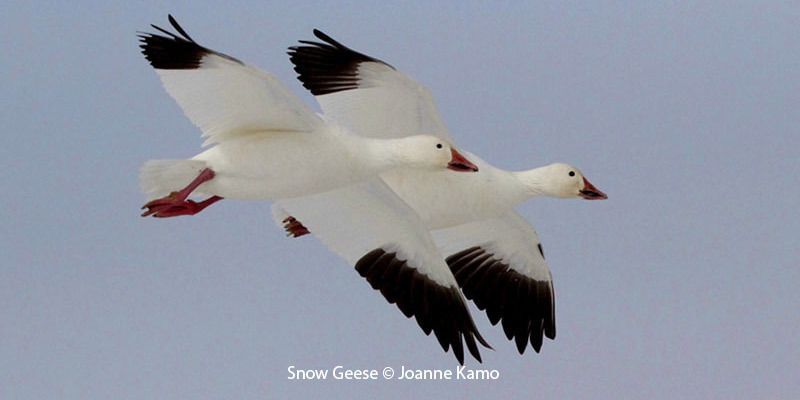
© David McDonald
Snow Goose Anser caerulescens
Family: (Anatidae) Ducks, Geese, and Swans
Preferred Habitat: Fields and marshes.
Seasonal Occurrence: Abundant in winter.
Profile by Glenn Olsen: One of the spectacular birds that winters here is the Snow Goose. This species has an interesting history. As birders know, the Snow Goose occurs in two basic morphs, viz. one with a white body and black-tipped wings and one with a blue-black body and a white head. There is more variability in the plumage color of the darker morph with varying amounts of white. We derive the common name of Snow Goose from the white morph. The dark morph is commonly referred to as Blue Goose, a nod to the species name. Caerulescens is Latin for cerulean or blue.
Before 1957, the Blue and Snow Geese were considered two separate species. I don't think the geese were confused about this, but the taxonomists were unsure. Before then the two species had widely separate breeding and wintering ranges. But as humans changed the habitat, especially that along the migratory route and the wintering habitat, the geese began to mix and mate on a regular basis. Scientists have since learned that the blue morph is due to a recessive gene and they are the same species. Additionally, at one time there was another population that was noticeably larger and known as the "Greater Snow Goose" C. c. atlanticus. Then we had the Lesser, Greater, and the Blue. But today they have all been "lumped" together as one species.
We do not have as large a population of wintering Snow Geese now as we did twenty years ago even though the overall population of the species is at an all-time high. This is due largely to loss of the rice farms that once dominated the Katy area. But the area is still a good location to find Snow Geese beginning mid-October when a few early migrants arrive. Greater numbers begin arriving toward mid-November and remain until around the end of February. During this time it is possible to see flocks of Snow Geese numbering in the thousands. What a sight! And the cacophony of a large flock of Snow Geese landing or taking to the air is a symphony to my ears.
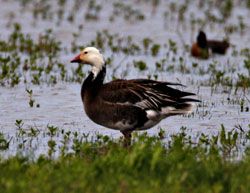
© David McDonald
Profile by Rachel Myers: The Snow Goose is a species of waterfowl that overwinters here in abundance on the upper Texas coast and surrounding areas. They arrive in huge flocks of hundreds to thousands of birds, surrounding the sky in a cacophony of honks. In large numbers, it almost feels like falling snow around you as they land.
There are two subspecies of Snow Goose: The Lesser Snow Goose and the Greater Snow Goose. The Greater Snow Goose is slightly larger, nests further northeast than the lesser, and has no color phases. Lesser Snow Geese, however, have two distinct morphs, white and blue. White morph Snow Geese are all white with black primary feathers, pink feet, and a pink bill with a black grin patch. Blue morph Snow Geese have a variably dark body, white armpits visible in flight, and a white head. They also have the same pink feet and bill with a grin patch like the white morphs.
The Snow Goose can be confused with the Ross’s Goose as they are similar in color and have two morphs. Ross’s Geese are smaller than Snow Geese and have smaller bills. One of the main differences if you can see them close enough is that the Ross’s Goose lacks the black grin patch that Snow Geese have. The call of the Snow Goose is a one-syllable honk. Calls are given at any hour of day or night, any time of the year, in the air or on the ground. However, birds that are less than a year old have a clearer and high-pitched whistle.
Snow Geese breed in colonies on the Canadian and Northern Alaska tundra, close to the coast, from the high arctic to the subarctic. They preferably choose areas near shallow lakes, ponds, salt marshes, or streams. After chicks hatch, families move to brood-rearing territories with an abundance of grasses and bryophytes. During spring and fall migration, Snow Geese travel thousands of miles and frequently stop in open areas like farm fields and lakes. They winter in areas on American coasts and some inland areas, preferring open habitats such as agricultural fields, wetlands and grasslands.
Snow Geese only eat plant material, including grasses, sedges, rushes, forbs, horsetails, willows, and shrubs. They will consume nearly any part of the plant including seeds and roots. They will also eat grains and berries during the winter. Snow Geese stay with the same mate for life, choosing a mate of the same color morph as the family they grew up with. The female chooses the nest site and builds the nest on her own on dry ground if possible. The female often plucks her own down feathers and adds them to the nest as she lays more eggs. She may also add plant material to add more structure to the nest. The average Snow Goose nest can range from three to six and a half feet across. The average clutch size of a Snow Goose is anywhere from two to six eggs.
Snow Geese are a spectacular winter migrant to observe here on the upper Texas coast. Greater Snow Geese migrate to the mid-Atlantic coast to winter, where Lesser Snow Geese winter in the Gulf Coast of Texas, Louisiana and Mexico. So, if you see a Snow Goose in the area, it is more than likely a Lesser Snow Goose. A great place to observe them is Anahuac National Wildlife Refuge where they can be seen by the hundreds to thousands in the areas surrounding Shoveler Pond along with many other species of waterfowl. Don’t forget to listen for honks and look above you as Snow Geese will often fly over in large flocks in the area.
Note: According to Wikipedia, the species was previously placed in the genus Chen but is now typically included in the "gray goose" genus Anser.
-
Cornell Lab of Ornithology
-
Field Guide
-
Bird Library
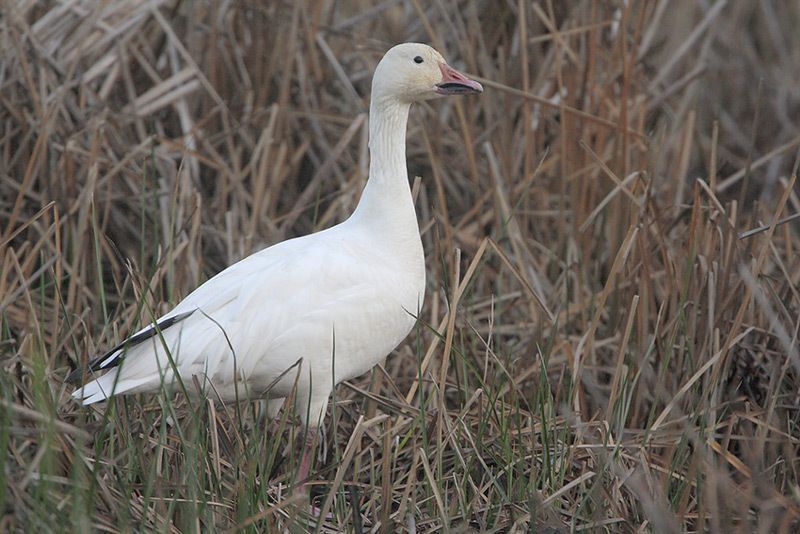
© Greg Lavaty, www.texastargetbirds.com
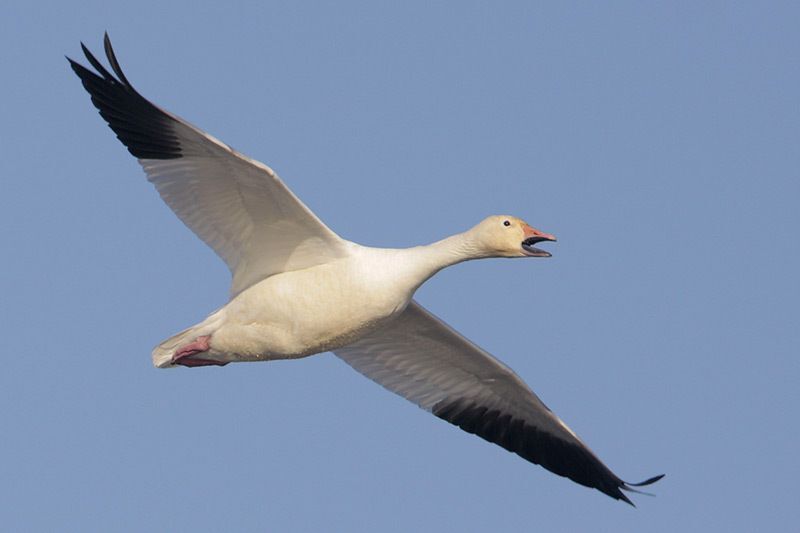
© Greg Lavaty, www.texastargetbirds.com
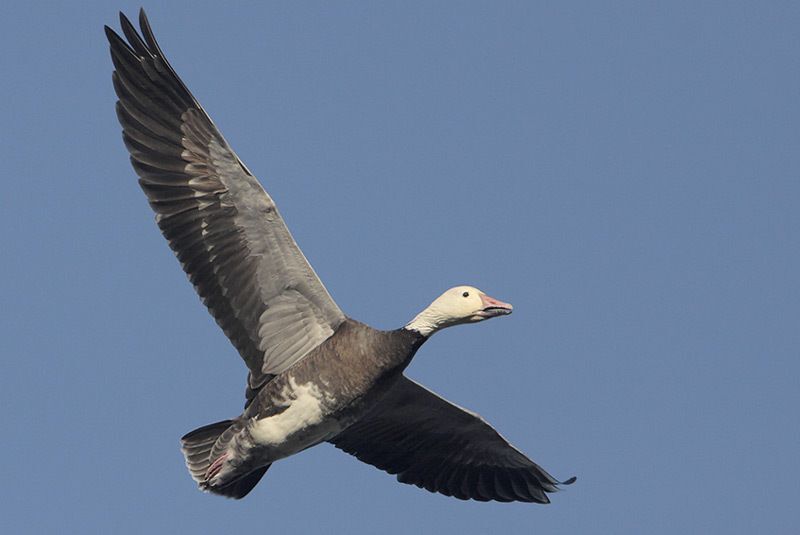
© Greg Lavaty, www.texastargetbirds.com
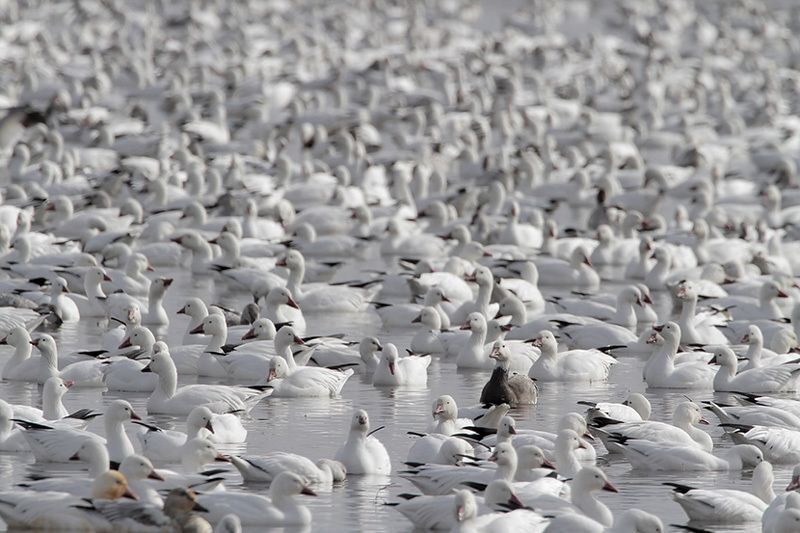
© Greg Lavaty, www.texastargetbirds.com

